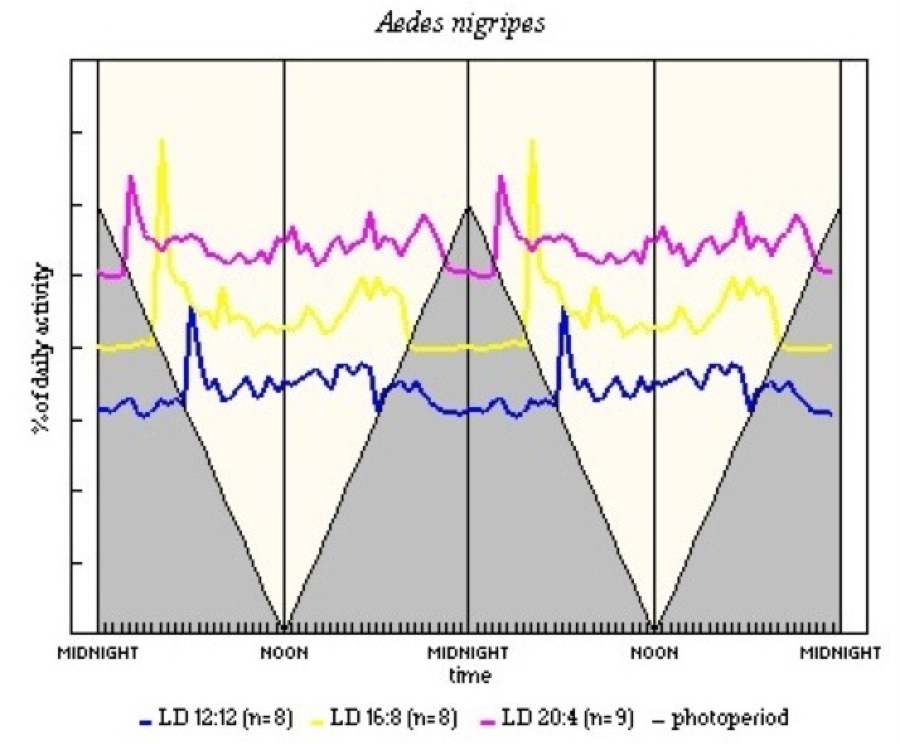

Biological Clocks in Mosquitoes - Section 2
|
The photoperiodogram (Figure 1) shows that it clearly is a day-active species. In LD 12:12 and LD 16:8 there are E' and M peaks, with some activity before light-on in LD 12:12. In LD 20:4 there appears to be a trimodal pattern, with M, mid-day and E' peaks; the single LD 23:1 day shows more of a late M, low mid-day, and E' pattern. In all four regimes activity dropped before light-off and E' appears to follow light-on by some 14-18h, this is most noticeable in the longer L regimes. Activity around 6h after light-off also can be seen in all four LD regimes. This is at a low level, perhaps due to inhibition by dark, in LD 12:12 and LD 16:8.
Figure 1

The photoperiodogram (Figure 2) shows that it clearly is a day-active species. In LD 12:12 and LD 16:8 there are E' and M peaks, with some activity before light-on in LD 12:12. In LD 20:4 there appears to be a trimodal pattern, with M, mid-day and E' peaks. There is an activity peak some 8h after light-off in all three LD regimes, albeit very small in the D of LD 12:12. The E' peak falls some 15h after light-on, giving a minor rise in activity after light-off in LD 12:12.
Figure 2

The laboratory recordings show a pattern which has most activity within a period of 12-16h centred around noon (the mid-day peak). This is particularly clear in LD 23:1, and would satisfy both the crepuscular pattern of lower latitudes, with long summer days (L 16-18h or more), and Arctic conditions, where there is continuous daylight but cycling of light intensity and, hence, of temperature levels. The main peak of all Ae. nigripes field activity (emergence, flight, host-seeking and oviposition) was around solar noon, although environmental factors, e.g. temperature, wind speed and humidity, could alter the pattern considerably. The laboratory patterns would satisfy both Arctic and lower latitude situations. In both species, the M peaks following light-on could be startle responses but against this is the broad decline from the peaks, plus the fact that a small rise in activity some 4-6h before light-on can be seen in LD 12:12 (an L regime shorter than the daylengths of high summer in which these species are active). The entrainment of M, therefore, could well be due to light-off some 6-8h previously. The timing of the late-afternoon E' peak seems most likely to be entrained by light-on. In Ae. impiger the strongest evidence is seen in LD 23:1, and in Ae. nigripes it is supported by the continuance of activity after light-off in LD 12:12.
For such northern species, where low temperature is a fact of life, mid-day activity is hardly surprising. Even in equatorial regions, however, there are mosquitoes which are wholly day-active. For instance, Aedes hebrideus and Armigeres breinli in the South Pacific Islands (personal observation, see Taylor & Maffi, 1978); a characteristic of both is that they are predominantly black in colour and keep in the shade of tree cover. The author also has experienced intense attack in full sunlight by a Culicine species in the rice fields of Central Colombia.
|
©1998, 2010 - Brian Taylor CBiol FSB FRES 11, Grazingfield, Wilford, Nottingham, NG11 7FN, U.K. Comments to dr.b.taylor@ntlworld.com |